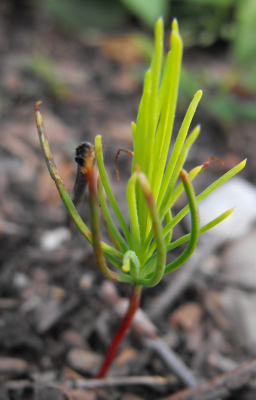
Seed stratification problems
 Is
that a baby stone pine? Hmm, I don't
know. What do you think?
Is
that a baby stone pine? Hmm, I don't
know. What do you think?
The problem with my stratification method --- toss the seeds in
a garden bed and wait over the winter --- has become clear. I
very rarely mark anything in the garden because I write down which bed
I've planted seeds in and I know how to distinguish vegetable seedlings
from weed seedlings. But what do you do when you've planted seeds
that will turn into unknown seedlings, like the stone pine, honey locust,
and persimmon seeds
I popped into the garden to stratify this winter? By definition,
these guys need extensive time in the ground before they'll sprout,
which means I've been scared to weed those beds for the last six months
in fear I'll pull out my tree seedlings. Now I'm left wondering
whether a few odd seedlings are the ones I've been waiting for, or
whether my carefully collected seeds came up and choked amid the weed
patch.
I can't believe I'm
saying this, but winter
sowing would have
come in handy here. That's actually how I started my first
persimmon seeds --- I popped them in a pot of soil and forgot about
them until seedlings miraculously sprang up many months later.
Maybe I'm going to have to start this experiment over next year,
keeping better track of where my slow-to-germinate seedlings are
located?
| This post is part of our Farm Experiments lunchtime series.
Read all of the entries: |
Want more in-depth information? Browse through our books.
Or explore more posts by date or by subject.
About us: Anna Hess and Mark Hamilton spent over a decade living self-sufficiently in the mountains of Virginia before moving north to start over from scratch in the foothills of Ohio. They've experimented with permaculture, no-till gardening, trailersteading, home-based microbusinesses and much more, writing about their adventures in both blogs and books.
Want to be notified when new comments are posted on this page? Click on the RSS button after you add a comment to subscribe to the comment feed, or simply check the box beside "email replies to me" while writing your comment.
